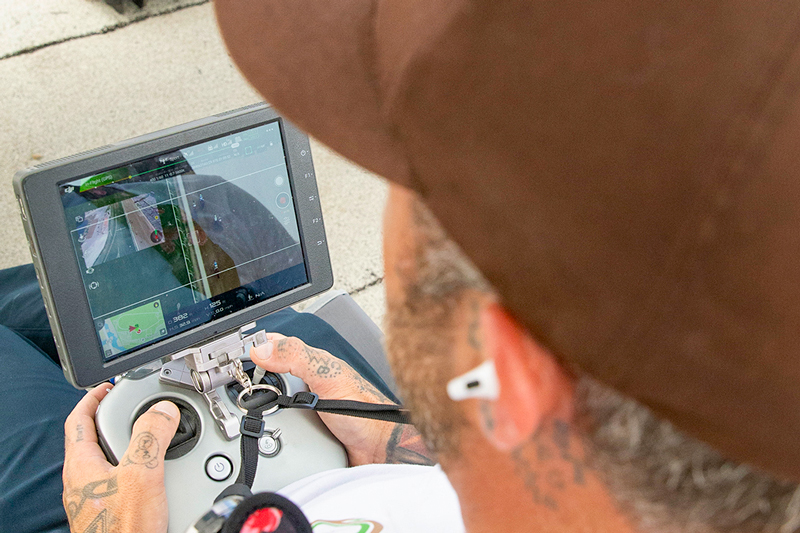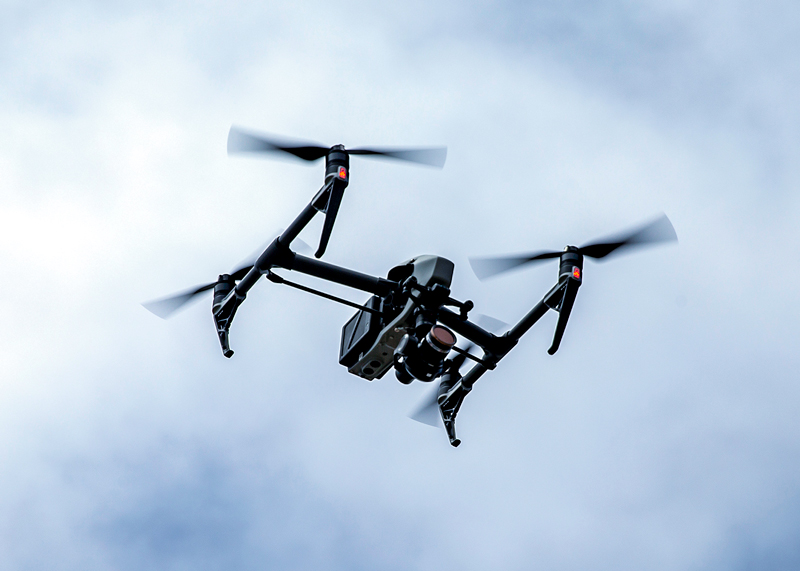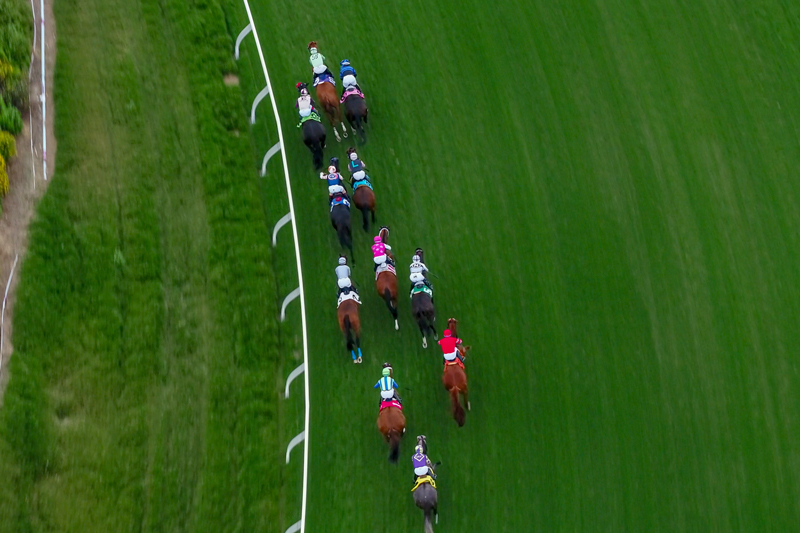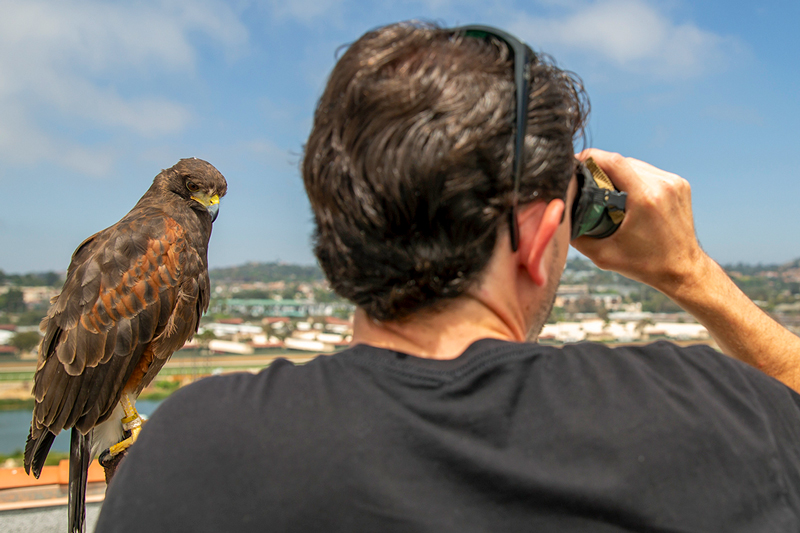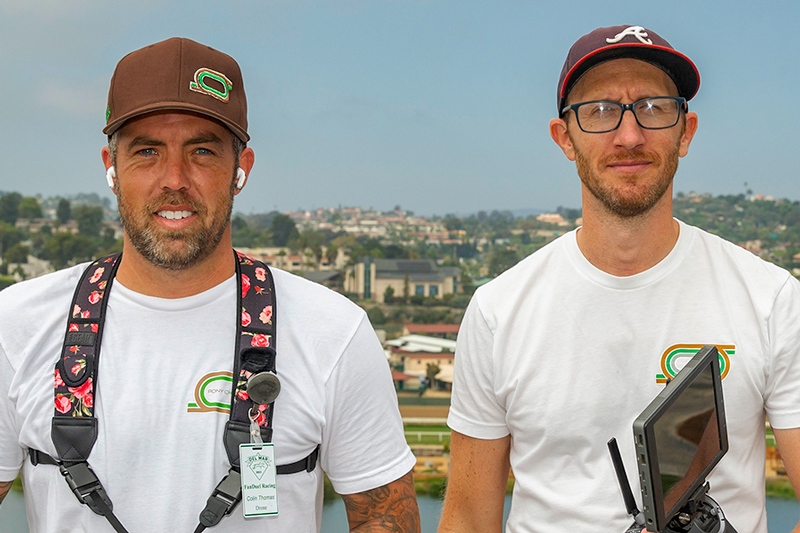
Colin Thomas (left) and Andrew Garrett (Benoit Photo)
Drones Capturing Thoroughbreds From High in the Sky this Summer at Del Mar
By Brigitte Becko
With the rise of the new tech era, Del Mar is keeping up to date with innovative technology. Starting just two summers ago, Colin Thomas of Pony Chasers was asked to create the first drone program at the Del Mar racetrack. This led several other tracks around the country down the same path. It truly is a brilliant new perspective for stewards and patrons alike. Let’s meet the drone pilot, the camera operator and the falconer that pull this operation together.
Colin Thomas is Del Mar’s drone operator. He started his career as a roadie, but when his beautiful daughter was born, he promised himself he would find a job where he could be close to her at all times.
Thomas had been intrigued by film production from the technical side. The San Diego local turned to friends in the business and searched YouTube to learn everything he could within the film industry. In 2015 he picked up his first drone.
“Within a minute of flying,” Thomas says, “I had an overwhelming feeling that this was how I was going to provide for my family.”
From then on it has been his passion.
Certified by the FAA as a drone pilot and flying for nearly eight years now, Thomas has settled into his new career. He’s always had an obsession with learning new skills.
“I like knowing how the brain of it works,” Thomas says. “I want to know how to rip it apart and put it back together if I need to repair something.”
Fueled by his new passion he embarked on a freelancing journey. He leveraged his contacts in the sports and music industry such as Coachella, Outside Lands and aerial automation rigging for Katie Perry’s Prism tour. While working as a stage manager for Nitro Circus, a freestyle action sports tour which choreographs shows on portable mega ramps, the dirt bike riders saw Thomas’ drone hobby as a fun opportunity.
“They saw what I was doing with the drone and asked me on off days to film them,” Thomas says.
Soon enough Thomas had a full portfolio to show new clients throughout all different industries.
“I started getting jobs, mostly for sports,” Thomas notes. “I did that for a couple of years chasing the whole freelance world.”
Soon after getting hired to be a drone pilot, he got into editing, all self-taught through YouTube. He produced everything from real estate videos to performing eagle observations for the Wildlife Research Institute. He has had the privilege now of traveling all over the world doing what he loves.
While his career in drone flying was taking off, he was still struggling. Driving up and down from Los Angeles for freelance work and not knowing how much longer he could wait months for his delayed paychecks. But then San Diego Gas & Electric called asking if he had an Inspire 2 drone with an X5S camera and without missing a beat he said yes.
One problem. He didn’t have an Inspire 2 drone with an X5S camera.
“I got on the phone and called friends who could spot me the money,” Thomas says, and they came through.
“The Inspire was my dream drone for the longest time, and now I have four.” he says.
His newest challenge came swooping into his voicemails in 2021. TVG (now Fanduel Racing) called asking for him to come by Del Mar to give them a demonstration on what it’s like to fly a drone. With his gear in hand, he met the managers of the broadcasting network, the safety stewards and a few more executives to demonstrate his skills.
With no prior knowledge of horse racing, Thomas says at first, he was nervous. But the safety steward explained they just wanted to hear the level of noise, and Thomas sent his drone 300 ft. above the empty parking lot.
Later on, this would become the norm. The drone following the horses from the starting gate, trailing 250 feet behind and 200 feet above. Thomas was tense during the demonstration but was confident in his flying abilities. He explained that it was a dark day with no crowds or the pounding of hooves to drown out the noise from the drone. He was able to answer their questions with confidence and got a call two weeks later with the green light to proceed with Del Mar’s new perspective on horse racing.
Thomas was asked to come back for opening day 2021. Now he has over 3,500 races under his belt.
“I have learned so much,” Thomas says. “But achieving the ideal shot in horse racing, while also abiding by safety guidelines and the rules established by the stewards, is incredibly challenging without a dual operator system.”
Horse racing is a fast and competitive sport. Thrilling for trainers, jockeys and patrons alike, holding traditions of entertainment dating all the way back to the ancient Romans. Showcasing these Thoroughbreds’ pure athleticism and elegance on the track is spectacular to watch.
“It can be hard to keep up with horses going close to 40 miles per hour,” as former jockey and now racing steward Luis Jauregui says.
Thomas explained that staying within the parameters of the safety guidelines and ability to keep the camera on target can be difficult work alone. This is where Thomas’ partner, Andrew Garrett, comes in as this summer’s drone camera operator.
Graduating from the University of the Arts in Philadelphia with a film degree, Garrett discovered drones in 2014 and has been at the track now for two years. The two met for the first time on their first day at the track back in 2021 and they have stayed flying partners ever since.
“My favorite part about flying for horse racing is the reliability of my responsibilities,” Garrett says. “I know I can execute… what I am supposed to do each and every race effectively each and every time. I have never found it to be boring because each race holds its own set of challenges… different things happen throughout the race and cause you to have to make creative choices as you go.”
On the rooftop Thomas and Garrett work their magic. They communicated with each other through each turn, the speed at which the horses were moving, and following the groupings of the horses as well as managing the weather parameters is impressive.
“You always have to stay on your toes,” Garrett states. “You can’t do the exact same thing each time”
Like other challenges they still have difficulty under air traffic control. Not helicopters or airplanes, but our native seabirds. Last year seagulls dive-bombed them a few times during take-off and landing because the drone was too close to their nest. The issue has been taken care of carefully and considerately by professionals.
Even so, they now have a bodyguard with them at all times thanks to Conor Bucalo, Del Mar’s falconer, and his hawk named Rufous.
“When I first got the call in 2021,” Bucalo states, “I was expecting to be protecting patron’s fries, not a drone.”
Now after a year on the job, Bucalo finds a relatability to the sport saying he has been surrounded by wild animals his whole life and he appreciates the uniqueness in the sport.
Being updated on their licenses every two years isn’t the only thing Thomas and Garrett need to stay up to date on. With big events, such as this year’s Preakness, they needed to file for what’s called a Special Government Issue (SGI) waiver with the Federal Aviation Administration (FAA). This form is a special government waiver requesting access to fly in specific longitude and latitudes. Thomas himself says that he has developed a relationship with a member of the FAA in Washington that he files his paperwork with.
The Stewards knew that a shot like the one captured by the blimp in the first Breeders Cup in 1984 was needed. Now, a similar shot is replicated today by Thomas’ drone.
Steward Jauregui says that there is always a concern for the safety of the horses so there have been procedures for the drone pilots to follow on race days. The drone stays inside (turf-side), during a dirt race for over a mile allowing for any mishaps that do happen to not affect the horses and riders. The same goes for a turf race where the drone stays outside on the dirt side till the last turn finally following the horses directly behind going down the stretch.
The most important aspect of this new saddle in the sky is the blind spot going into the turns on the quarter and the 3/8ths poles. Having this angle makes these corners no longer a blind spot. This allows the stewards to have “a direct headline shot” of the paths each horse is taking around the turn. Now the stewards can make a more conclusive judgment on rulings for each race. The video evidence is then shown through replays to patrons and bettors alike.
Thomas saw horse racing as an opportunity and created a company called the Pony Chasers. They have been hired nationwide now to film horse races from the “saddle in the sky.” They like to call themselves “aerial horse tracking experts.”
“They’re a good team,” Bucalo states after working beside the two for a year now. “So much so they finish each other’s sentences.”
Both Thomas and Garrett encourage people they meet to get into flying or simply learning about drones. Even Thomas’ 5-year-old daughter has learned to fly with him, starting at the impressive age of 3.
Both Thomas and Garrett say their favorite tracks to fly at are the Southern California tracks, specifically Del Mar for its beauty and amazing weather.
Can you spot the drone in the air trailing the horses? You can come to Del Mar and give it a try.



